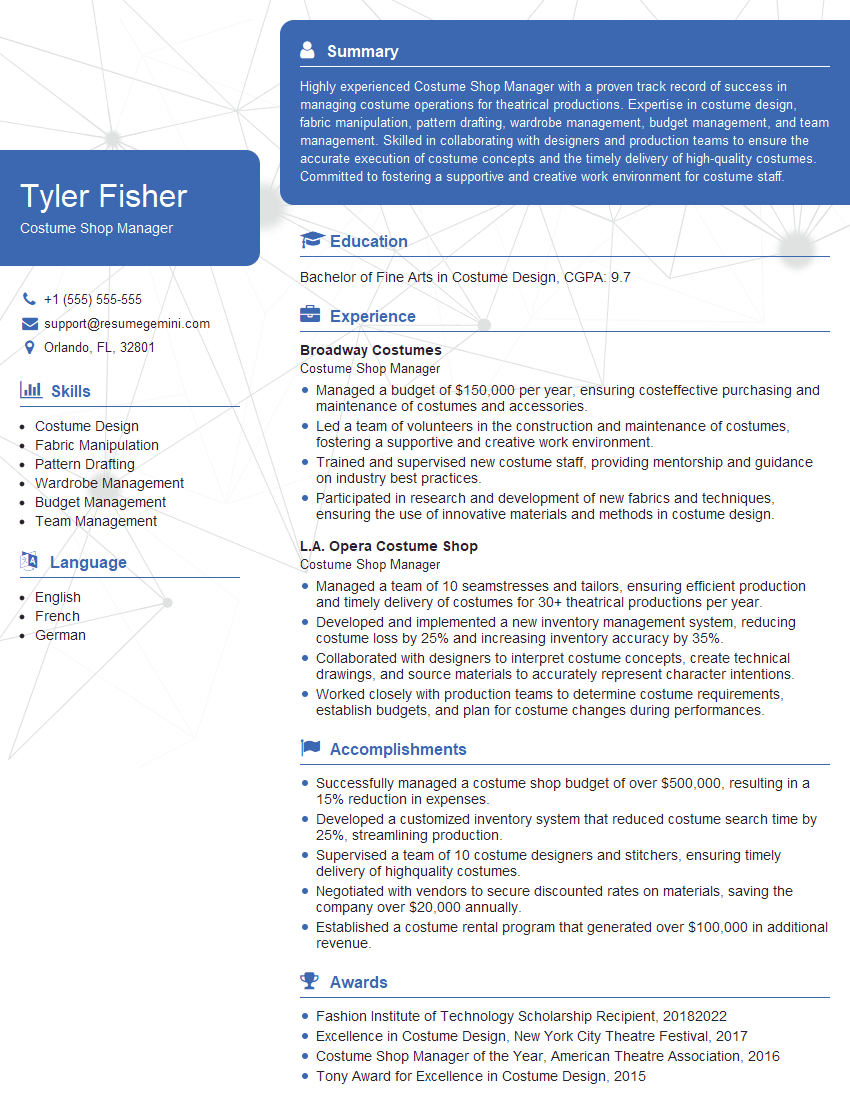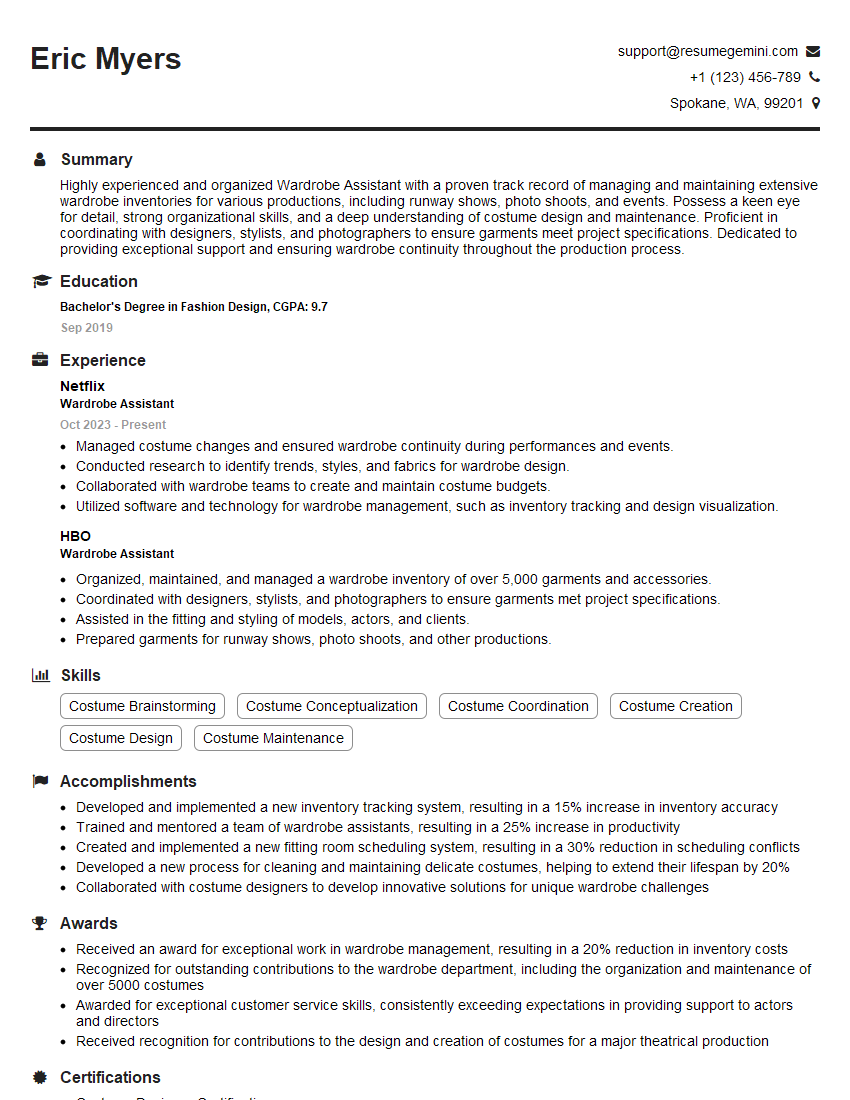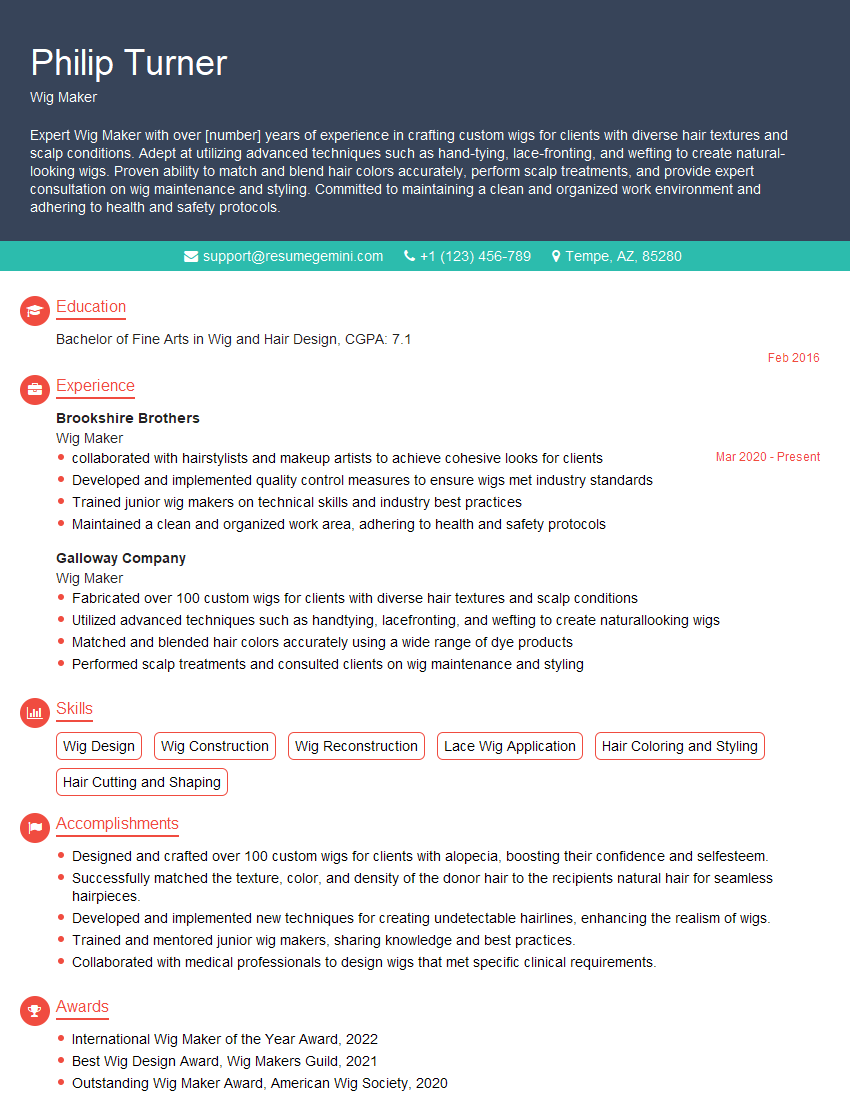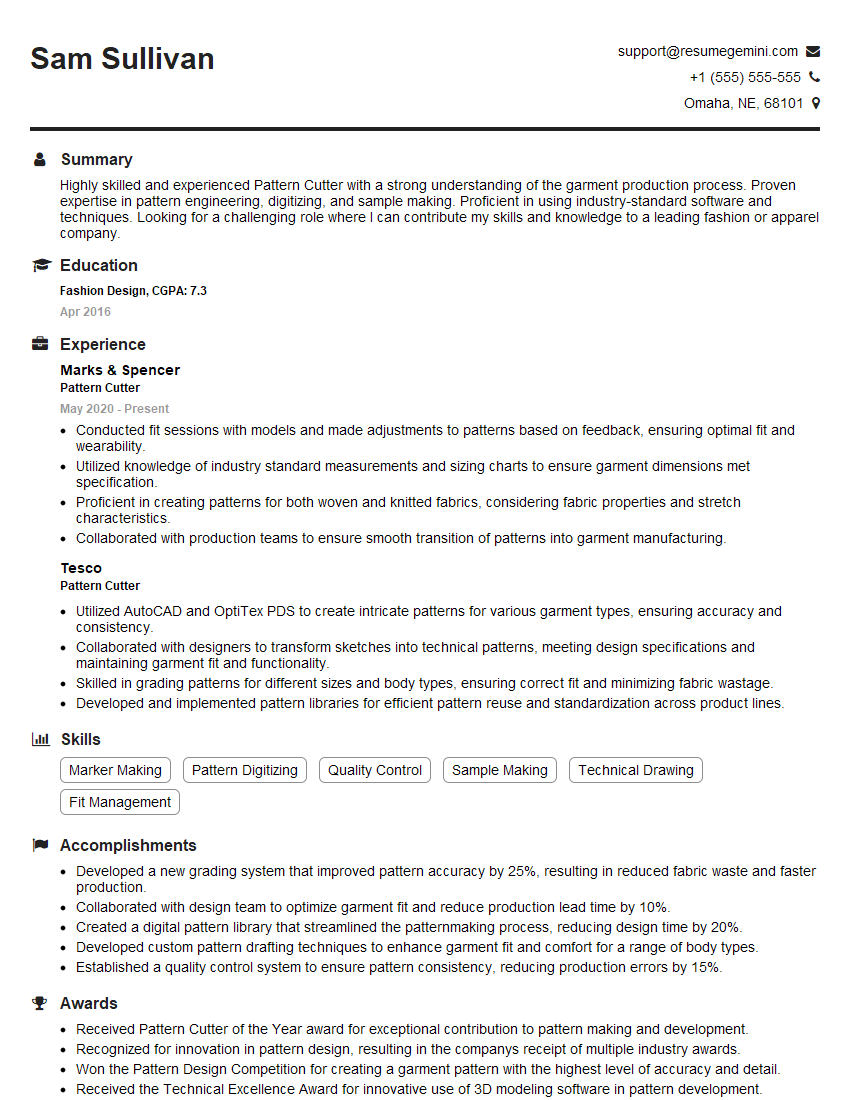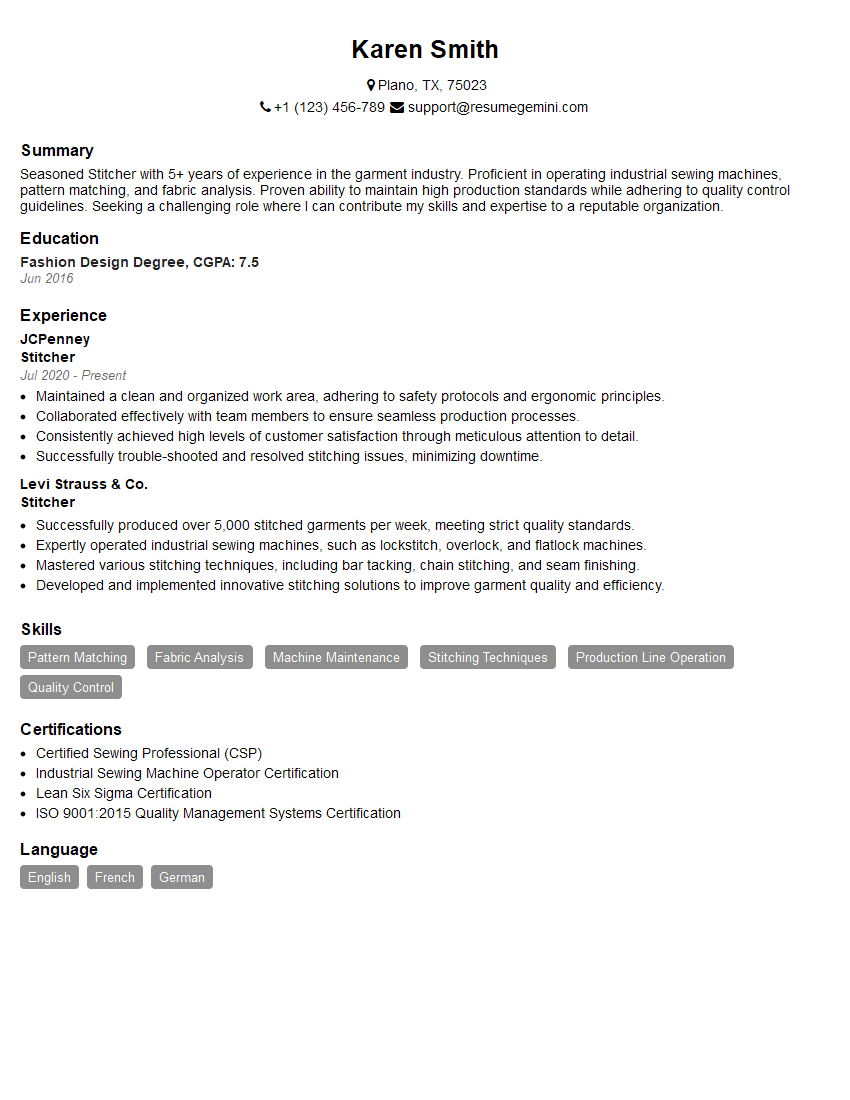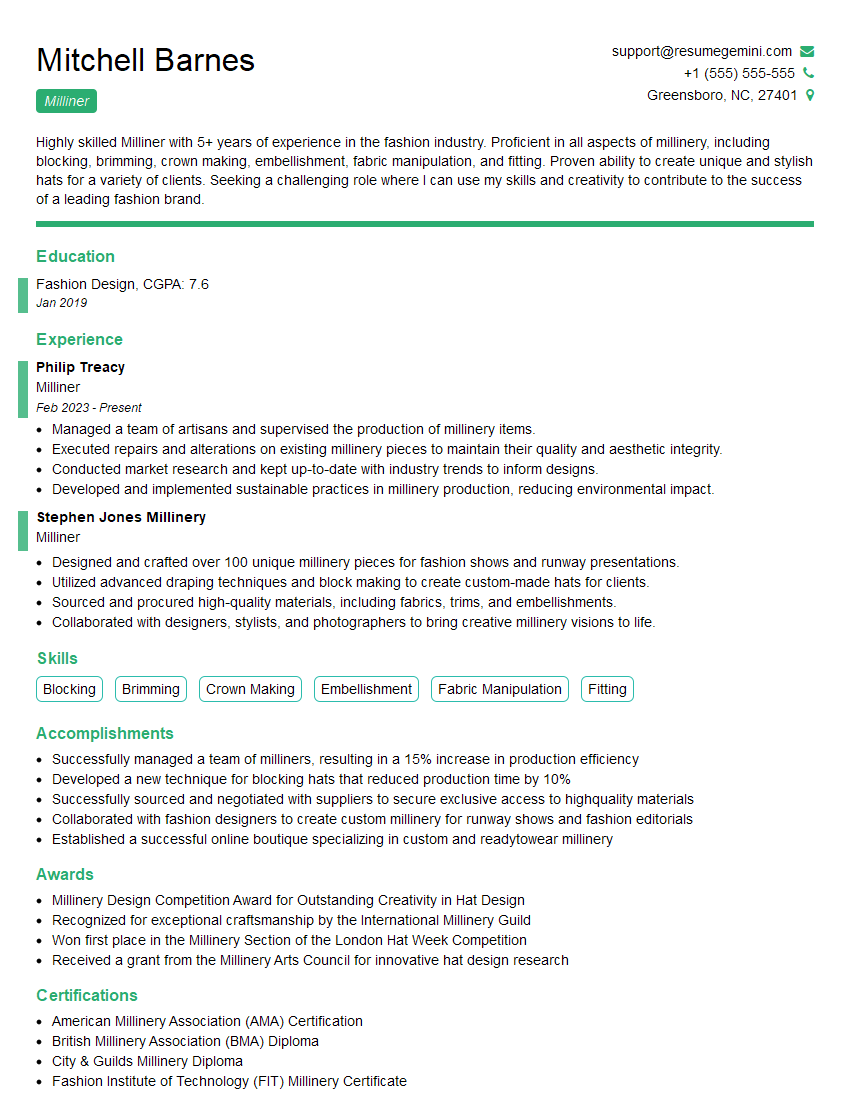Preparation is the key to success in any interview. In this post, we’ll explore crucial Costume Production Management interview questions and equip you with strategies to craft impactful answers. Whether you’re a beginner or a pro, these tips will elevate your preparation.
Questions Asked in Costume Production Management Interview
Q 1. Describe your experience with budget management in costume production.
Budget management in costume production is crucial for ensuring a successful and financially responsible project. It’s not just about tracking expenses; it’s about proactive planning and strategic allocation of resources. My approach begins with a thorough breakdown of the costume design, identifying every element – from fabric and trims to labor costs and potential rentals. I then create a detailed budget spreadsheet, categorizing expenses (e.g., materials, labor, alterations, rentals, shipping) and assigning realistic costs based on historical data and market research. This spreadsheet serves as a living document, constantly updated throughout the production process. For example, on a recent period piece, I initially budgeted $5,000 for fabrics. However, after sourcing various samples, I found a supplier offering a comparable quality at a lower price, resulting in $500 in savings. These savings were then strategically allocated to enhance other aspects of the costume design, such as upgrading the quality of the trims.
Regular monitoring of the budget, comparing actual expenses to the planned budget, is essential. Any significant deviations are investigated and addressed promptly. This could involve renegotiating supplier contracts, seeking alternative materials, or optimizing the construction process. Transparency is also key; I maintain open communication with the production team and relevant stakeholders to ensure everyone is informed about the budget status.
Q 2. How do you prioritize tasks in a fast-paced costume production environment?
Prioritization in a fast-paced costume environment requires a clear understanding of dependencies and deadlines. I utilize a combination of techniques, including a visual project management board (like a Kanban board), a detailed production schedule, and regular team meetings. The project board allows us to track the progress of each costume element, visually identifying bottlenecks or delays. The schedule, broken down into specific tasks with assigned deadlines, provides a clear roadmap. For example, tasks requiring specialized skills (like elaborate embroidery) are scheduled well in advance to avoid delays. Regular team meetings ensure everyone is aware of their responsibilities and any potential challenges. I typically employ a system of prioritizing tasks based on urgency and importance, using a matrix that weighs the impact of delay against the time required for completion. This helps in making informed decisions on resource allocation and task sequencing.
Think of it like an orchestra: While every instrument is crucial for a successful performance, the conductor prioritizes sections based on the piece’s structure and tempo. Similarly, in costume production, prioritizing tasks ensures we deliver the most critical elements on time, even under pressure.
Q 3. Explain your process for sourcing and selecting fabrics for a production.
Sourcing and selecting fabrics is a multi-step process that starts with a deep understanding of the design requirements. I begin by collaborating with the costume designer to analyze the script, character descriptions, and visual references to determine the appropriate fabrics for each costume. This includes considering factors like texture, color, drape, durability, and cost. Then, I research fabric suppliers, considering factors like price, quality, availability, and ethical sourcing practices. I often request samples from multiple suppliers to compare quality and cost in person. For example, when working on a historical drama, I might research fabric mills specializing in period-appropriate textiles.
Next, I conduct thorough fabric testing. This includes checking for colorfastness, shrinkage, and overall durability. Once suitable fabrics are identified, I create detailed specifications for each costume piece, ensuring consistency in material choices throughout the production. It is crucial to have enough fabric purchased to account for shrinkage and potential errors during construction.
Q 4. How do you manage alterations and fittings for a large cast?
Managing alterations and fittings for a large cast requires meticulous organization and communication. I create a detailed fitting schedule, scheduling actors based on their availability and costume complexity. I designate a dedicated fitting room and a team of skilled assistants to handle alterations efficiently. Each fitting is meticulously documented, with notes on necessary alterations, including measurements and sketches. This ensures continuity between fittings and helps track progress. For example, if an actor needs adjustments to the shoulder seams of their jacket, the adjustment notes include specific measurements and a sketch illustrating the exact changes needed.
A digital system for tracking alterations, such as a spreadsheet or dedicated software, helps maintain order and prevents confusion. Using clearly labeled garment bags and identification tags on each costume helps prevent mishaps. Finally, clear communication is key; I maintain close communication with the actors and the design team, ensuring everyone is informed about the fitting schedule and progress on alterations. This streamlined process ensures fittings proceed smoothly and efficiently, even with a large cast.
Q 5. What software or tools do you use for costume inventory and tracking?
For costume inventory and tracking, I utilize a combination of software and manual methods. For smaller productions, a well-organized spreadsheet, incorporating information like costume ID, description, assigned actor, and location, suffices. This spreadsheet allows for tracking individual pieces, identifying missing elements, and managing maintenance. For larger productions, dedicated software solutions, such as FileMaker Pro or specialized costume inventory management systems, are incredibly beneficial. These systems offer advanced features such as barcoding, image uploads, and reporting capabilities, offering a more comprehensive solution for managing large numbers of items and tracking their movement throughout the production. These systems help avoid costly delays or even the loss of a significant costume piece.
Regardless of the system used, maintaining accurate and up-to-date records is critical. Regular audits of the inventory help identify discrepancies and maintain the system’s integrity. The chosen method should ultimately streamline the tracking process and improve efficiency.
Q 6. How do you handle unexpected delays or challenges during production?
Handling unexpected delays or challenges requires a proactive and adaptable approach. When faced with a setback, my first step is to assess the impact of the delay on the overall production schedule. I then convene a team meeting to brainstorm solutions, involving all relevant personnel to leverage diverse perspectives. This collaborative approach helps identify alternative solutions, mitigating the impact of the delay. For example, if a crucial fabric shipment is delayed, we might explore alternative fabrics or adjust the design to accommodate the delay, ensuring the production stays on track.
Open communication is critical. I keep all stakeholders informed about the issue and the proposed solutions, managing expectations and avoiding surprises. Documentation of the problem and the steps taken to resolve it is equally important, as this forms a valuable record for future productions. Flexibility and resourcefulness are key to navigating unexpected challenges effectively.
Q 7. Describe your experience with creating and managing a costume budget.
Creating and managing a costume budget is an iterative process that begins long before the production starts. It requires a deep understanding of the production’s scope, the design concept, and the available resources. The process starts with initial budget estimations based on historical data, market research, and discussions with the costume designer. This often involves creating a preliminary breakdown of anticipated costs for materials, labor, rentals, and other relevant expenses. These estimates are then refined as the design develops and more specific information becomes available.
I use a detailed spreadsheet to track actual expenses against the planned budget, regularly monitoring for potential overruns and identifying areas for cost savings. This involves consistent tracking and comparison between the planned and actual cost for each item, category, and the whole production. For example, if the initial budget for fabrics is exceeded, we explore alternative sourcing or modify the design to reduce material usage. Transparent communication with the production team and stakeholders ensures everyone is aware of the budget status and any necessary adjustments.
Q 8. How do you ensure the timely completion of costumes within a production schedule?
Ensuring timely costume completion hinges on meticulous planning and proactive management. It’s like orchestrating a complex symphony – each instrument (costume piece) needs to be ready at the right time.
- Detailed Schedule: I create a comprehensive production schedule, breaking down each costume into its constituent parts (pattern cutting, fabric sourcing, construction, fitting, alterations) with specific deadlines for each stage. This schedule is shared with the entire team and regularly reviewed.
- Resource Allocation: I assess the resources needed – fabric, trims, personnel – and allocate them efficiently. This might involve prioritizing costumes with tighter deadlines or utilizing skilled seamstresses for intricate work.
- Progress Tracking: Regular progress meetings and daily check-ins are crucial. I utilize spreadsheets or project management software to monitor progress, identify potential bottlenecks, and address issues proactively. This allows for adjustments to the schedule if necessary.
- Contingency Planning: Unexpected delays are inevitable. I build buffer time into the schedule and have backup plans for potential problems, such as fabric shortages or unforeseen technical difficulties. For example, having a secondary fabric supplier or a backup seamstress.
- Communication: Open and consistent communication with the entire team is essential to ensure everyone is aware of deadlines, challenges, and solutions. Daily briefings and regular email updates keep everyone informed.
For example, on a recent Shakespearean production, we had 40 costumes needed for the opening night. By meticulously scheduling each phase, from initial design sketches to final fittings, and actively managing the team, we not only delivered all costumes on time but also ensured they were of the highest quality.
Q 9. Explain your understanding of different fabric types and their suitability for specific costumes.
Understanding fabric types is paramount. It’s like choosing the right paint for a masterpiece – the wrong choice can ruin the whole effect. The fabric’s weight, drape, texture, and care requirements directly impact a costume’s appearance, durability, and the overall aesthetic.
- Silk: Luxurious drape, delicate, requires careful handling and dry cleaning. Perfect for elegant gowns or historical pieces.
- Cotton: Durable, breathable, versatile. A great option for everyday wear or rugged costumes.
- Linen: Strong, breathable, wrinkles easily. Suitable for historical pieces or summer wear. But unsuitable for situations requiring a pristine, wrinkle-free appearance.
- Wool: Warm, durable, but can be itchy. Ideal for period costumes or colder-weather settings.
- Synthetics (Polyester, Nylon): Durable, wrinkle-resistant, inexpensive. Suitable for less demanding costumes or undergarments but might lack the desired texture or drape for more elaborate pieces.
- Velvet: Luxurious, heavy, drapes well. Ideal for regal or opulent costumes but can be difficult to work with.
For instance, a delicate silk would be perfect for a Victorian-era ball gown, whereas a sturdy cotton would be more appropriate for a working-class character’s outfit in a period piece. Understanding these differences is crucial for both design and construction.
Q 10. How do you collaborate effectively with designers, actors, and other team members?
Effective collaboration is the cornerstone of successful costume production. It’s akin to a well-oiled machine, where every part plays its role seamlessly.
- Regular Meetings: I schedule regular meetings with designers, actors, and other team members to discuss design concepts, costume fittings, and any potential challenges. Open communication is key.
- Open Communication: I foster a collaborative environment where everyone feels comfortable expressing their ideas and concerns. This ensures that any issues are addressed promptly and effectively.
- Feedback Integration: I actively solicit and incorporate feedback from actors during fittings to ensure the costumes are comfortable, functional, and enhance their performance. The costume must support, not hinder, the actor’s role.
- Clear Communication: I use clear and concise language, providing detailed instructions and specifications to avoid misunderstandings. Visual aids, such as sketches or mood boards, are invaluable tools.
- Respectful Collaboration: I approach all collaborations with respect and empathy, recognizing that each team member brings a unique skill set and perspective to the project. This builds trust and rapport.
For example, during a recent musical production, I worked closely with the choreographer to ensure that the costumes were both visually stunning and practical for the dancers’ complex movements. This collaborative approach led to a successful and visually impressive show.
Q 11. Describe your experience with hiring and managing a costume crew.
Hiring and managing a costume crew requires a keen eye for talent and strong leadership skills. It’s like assembling a skilled orchestra – each musician must be proficient in their instrument, and the conductor must guide them harmoniously.
- Skill Assessment: I assess potential hires based on their skills, experience, and work ethic. This often involves reviewing portfolios and conducting practical assessments.
- Team Building: I create a positive and supportive work environment where team members feel valued and respected. This fosters a sense of camaraderie and mutual respect among the crew.
- Delegation: I delegate tasks effectively, matching each team member’s strengths and expertise to the appropriate projects. Clear roles and responsibilities are established from the start.
- Performance Monitoring: I monitor the team’s progress, provide regular feedback, and address any issues promptly. This ensures that the work remains on schedule and meets the required quality standards. This could involve regular check-ins on individual progress.
- Conflict Resolution: I have strategies for resolving conflicts in a fair and equitable manner. This often involves mediating disagreements and ensuring that all voices are heard.
In one instance, I successfully assembled a team of diversely skilled individuals—seamstresses, pattern makers, and drapers—to create the costumes for a large-scale historical drama. My focus on clear communication, effective delegation, and supportive leadership resulted in a high-quality product delivered on time and within budget.
Q 12. How do you maintain the quality and condition of costumes throughout a production?
Maintaining costume quality and condition throughout a production is crucial. It’s like preserving a valuable artwork— careful handling and regular maintenance are essential.
- Pre-Show Inspection: Before each performance, I conduct a thorough inspection of all costumes to identify any potential damage or needed repairs.
- Proper Storage: I ensure that costumes are stored properly, using appropriate hangers, garment bags, and storage containers to prevent damage, wrinkling, and soiling.
- On-Site Wardrobe: A dedicated wardrobe crew is responsible for handling costumes during performances, making any necessary adjustments, and promptly addressing any minor damages that may occur.
- Post-Show Cleaning: After each performance, costumes are cleaned and inspected. This might involve dry cleaning, hand washing, or spot cleaning, depending on the fabric. A detailed log is maintained for tracking cleaning.
- Repair and Maintenance: I have a system for tracking and addressing needed repairs. This could involve a designated repair person or outsourcing specific repairs.
For instance, in a demanding musical production, we used a detailed system for tracking costumes, including their cleaning and repair history, to ensure their longevity and readiness for each performance. This proactive approach saved considerable time and resources during the run.
Q 13. What methods do you use for documenting costume designs and specifications?
Accurate documentation of costume designs and specifications is essential. It’s like creating a blueprint for a building— without precise specifications, the final result can be flawed.
- Detailed Sketches and Renderings: I utilize detailed sketches and renderings to illustrate costume designs, including fabric choices, color palettes, and embellishments.
- Technical Specifications: I create technical specifications for each costume, including measurements, pattern pieces, fabric quantities, and construction techniques.
- Fabric Swatches: I maintain a library of fabric swatches to ensure consistency in fabric choices throughout the production.
- Digital Design Software: I leverage digital design software such as Adobe Illustrator or Photoshop to create detailed designs and technical drawings.
- Photographic Documentation: I maintain photographic records of the costumes during all stages of production, from initial design concepts to final fittings.
This comprehensive documentation helps to maintain consistency, manage inventory, and streamline the manufacturing process. It is especially valuable if the production needs to be replicated later, or for insurance purposes.
Q 14. How do you resolve conflicts or disagreements within the costume department?
Conflict resolution is an essential skill in costume production. It’s like navigating a ship through a storm—calm, decisive leadership is essential.
- Open Communication: I encourage open communication among team members, providing a safe space for them to express their concerns and perspectives.
- Active Listening: I actively listen to all parties involved in a conflict, seeking to understand their perspectives before offering solutions.
- Mediation: I act as a mediator, helping to facilitate a constructive dialogue between conflicting parties.
- Compromise: I encourage compromise and collaboration, seeking solutions that address the concerns of all involved.
- Fairness and Impartiality: I strive to remain fair and impartial in resolving conflicts, ensuring that all decisions are based on objective criteria.
In one instance, a disagreement arose between a designer and a seamstress regarding the feasibility of a particular design element. By facilitating a discussion where both parties could clearly articulate their concerns, we reached a compromise that preserved the design’s aesthetic while making it practical to execute. This collaborative approach strengthened the team dynamic and improved morale.
Q 15. Explain your process for managing costume rentals and returns.
Managing costume rentals and returns requires a meticulous system to ensure smooth operations and minimize losses. My process begins with a detailed inventory database, tracking each costume’s condition, rental history, and availability. This database is usually software-based, allowing for easy searching and updating. When a costume is rented, I create a rental agreement specifying the rental period, fees, and conditions for return. This agreement includes clear photos of the garment’s condition before rental.
Upon return, the costume undergoes a thorough inspection against the initial condition report. Any damages are documented with photos and assessed for repair costs. The client is then billed accordingly. Cleaned and repaired costumes are then carefully stored and updated in the database. For high-demand items, I often prioritize their cleaning and repairs immediately to ensure quick turnaround for future rentals. A regular audit of the database helps to identify slow-moving items, allowing me to strategize pricing or potentially remove them from the rental inventory.
For example, on a recent historical drama production, we rented out several 18th-century gowns. Detailed photographs were taken before and after rental, and minor repairs (like a loose button) were noted and addressed before the costumes were returned to storage. This system ensures transparency and accountability throughout the rental process.
Career Expert Tips:
- Ace those interviews! Prepare effectively by reviewing the Top 50 Most Common Interview Questions on ResumeGemini.
- Navigate your job search with confidence! Explore a wide range of Career Tips on ResumeGemini. Learn about common challenges and recommendations to overcome them.
- Craft the perfect resume! Master the Art of Resume Writing with ResumeGemini’s guide. Showcase your unique qualifications and achievements effectively.
- Don’t miss out on holiday savings! Build your dream resume with ResumeGemini’s ATS optimized templates.
Q 16. How do you ensure the safety and well-being of your costume crew?
Ensuring the safety and well-being of my costume crew is paramount. This involves implementing several key strategies. First, a comprehensive risk assessment is conducted before any project begins, identifying potential hazards like needlework, sharp objects, or heavy lifting. Based on the assessment, I provide the team with appropriate Personal Protective Equipment (PPE), including safety glasses, gloves, and protective clothing, as needed.
Regular training is crucial. This includes instruction on safe handling of equipment like sewing machines, ironing presses, and dyeing chemicals. We also cover proper lifting techniques and emergency procedures. Furthermore, I maintain a clean and organized workspace, free from clutter and tripping hazards. Adequate lighting is essential to prevent eye strain and accidents. Open communication is encouraged; team members are reminded to report any unsafe conditions or injuries immediately.
For instance, during a recent large-scale opera production, we had daily toolbox talks to review safety protocols and address any emerging concerns. We also implemented a buddy system for handling heavy fabrics, ensuring everyone worked safely and effectively. This proactive approach minimizes risks and fosters a safe and positive work environment.
Q 17. Describe your experience with working within different production styles (e.g., film, theatre, opera).
My experience spans diverse production styles, including film, theatre, and opera. Each demands a unique approach to costume production. Film often requires a higher degree of detail and durability, with costumes designed to withstand multiple takes and potential rough handling. The pace can be fast-paced, and I have experience managing the pressure to deliver costumes on tight deadlines. Theatre involves more intimate interactions with the performers, requiring flexibility in fittings and alterations.
Opera productions often demand more elaborate and historically accurate designs. The scale is typically grander, requiring extensive coordination with other departments, such as set design and lighting. For example, on a recent film project, the emphasis was on creating durable costumes that could withstand vigorous movement and repeated use. In contrast, a theatrical production involved significant costume changes within the show, requiring quick-change systems and careful organization of costumes backstage. Opera productions have challenged me with intricate hand-stitching and historically accurate detailing, necessitating extensive research and sourcing of appropriate materials.
Q 18. How do you handle last-minute changes or revisions to costume designs?
Handling last-minute changes requires a flexible and adaptable approach. Clear communication is key. I immediately establish communication with the designer, director, and other relevant personnel to understand the nature and extent of the changes. We then assess the feasibility of implementing the revisions within the given timeframe and budget. If possible, I prioritize the changes based on their impact on the production.
For minor revisions, I may be able to make adjustments directly to existing garments or patterns. For major changes, I might need to create new patterns or source additional materials. We might need to adjust the production schedule, potentially requiring overtime or additional team members. I maintain clear documentation of all changes, including cost implications, to prevent any surprises down the line. For example, during a recent Broadway show, a last-minute change to a leading actor’s costume necessitated an overnight alteration. By prioritizing the alteration and effectively communicating with the team, we managed to have the revised costume ready in time for the next performance.
Q 19. What is your experience with different dyeing and finishing techniques?
My experience with dyeing and finishing techniques is extensive. I’m proficient in various dyeing methods, including natural dyes, reactive dyes, and acid dyes. The choice of dye depends on the fiber content of the fabric and the desired color. I understand the importance of proper dye fixation to ensure colorfastness and prevent bleeding. Finishing techniques such as distressing, aging, and printing add character and texture to the costumes, helping to achieve the desired aesthetic.
For example, I’ve used natural dyes like indigo to create authentic historical looks for a period drama, and reactive dyes for vibrant, modern costumes for a musical. I also have experience with different printing techniques such as block printing and screen printing. I prioritize eco-friendly practices wherever possible, such as using low-impact dyes and water-saving techniques. A strong understanding of fabric properties and dye chemistry is essential to avoid damage to the garments and achieve consistent results.
Q 20. Explain your understanding of health and safety regulations related to costume production.
Understanding health and safety regulations is crucial in costume production. This encompasses several aspects, including the safe handling of hazardous materials like dyes and adhesives, the proper use of machinery, and the prevention of workplace injuries. I always adhere to Occupational Safety and Health Administration (OSHA) guidelines, or equivalent local regulations. This includes providing proper ventilation when working with chemicals, using appropriate safety equipment, and implementing emergency procedures.
I ensure that my team is trained on safe practices and is aware of potential hazards. We also conduct regular inspections to identify and rectify any safety issues. Maintaining a clean and organized workspace helps minimize risks. Proper disposal of hazardous waste is essential to protect the environment and the health of the workers. For example, before any dyeing takes place, I make sure the workspace is well-ventilated, and all team members wear appropriate PPE, including gloves and eye protection.
Q 21. How do you maintain accurate records of costume purchases and expenses?
Maintaining accurate records is essential for budget management and inventory control. I utilize a computerized inventory management system that tracks all purchases, including fabric, trims, and accessories. Each purchase is documented with an invoice and details such as quantity, cost, and supplier. This data is categorized for easy reporting and analysis.
Expenses are meticulously tracked, and I regularly reconcile financial records with bank statements. A detailed budget is created at the start of each project, allowing me to monitor spending against planned costs and identify any potential overruns. Regular reports are generated to provide transparency and accountability. This system allows for informed decision-making and helps to optimize resource allocation. For instance, using a spreadsheet or dedicated software, I can easily track expenses related to fabric, thread, buttons, and other materials, and generate reports for budget monitoring and auditing purposes.
Q 22. Describe your experience with pattern making and alterations.
Pattern making and alterations are fundamental skills in costume production. My experience encompasses drafting patterns from scratch using both traditional methods (e.g., draping on a dress form) and digital techniques (e.g., utilizing CAD software like CLO3D). I’m proficient in adjusting existing patterns to fit various body types and creating custom patterns for unique designs. Alterations range from simple adjustments like hemming and taking in seams, to more complex tasks such as adding sleeves, altering necklines, and reconstructing damaged garments. For instance, on a recent musical production, I had to adapt a pre-existing pattern for a Victorian-era gown to accommodate an actress with a significantly different body type than the initial model. This involved intricate adjustments to the bodice, sleeves, and skirt, ensuring a perfect fit without compromising the overall aesthetic. I also have experience with grading patterns, scaling them up or down to produce garments in various sizes.
I use a systematic approach to alterations, always starting with careful measurements and sketching the changes before proceeding. This minimizes errors and ensures a seamless integration of modifications. My attention to detail and understanding of fabric drape allows me to create elegant and well-fitting garments, even with intricate designs.
Q 23. How do you handle damaged or lost costumes during a production?
Handling damaged or lost costumes is a crucial aspect of production management. My first step is always thorough documentation. Every costume is photographed and meticulously logged, including details about its condition and location. This creates an audit trail crucial for tracking and insurance purposes. If a costume is damaged, I assess the severity. Minor repairs are handled in-house by our skilled seamstresses, with a detailed record kept of the repairs performed and materials used. For significant damage, I’ll consult with the designer to discuss repair options or whether a replacement is necessary. Lost costumes require immediate investigation; I review the last known location, interview relevant personnel, and review security footage if available. A replacement would be created, mirroring the original as closely as possible, drawing upon pattern archives, photographs, and the original design documents. If the damage or loss is significant and impacts the show, I’ll collaborate closely with the production team to minimize disruption, which may involve adjustments to the schedule or the use of understudy costumes. I prioritize communication throughout the process, keeping relevant stakeholders informed every step of the way.
Q 24. What is your experience with creating and maintaining a costume database?
Creating and maintaining a costume database is essential for efficient production management. I have extensive experience in developing and managing such databases, leveraging software like FileMaker Pro, spreadsheets like Excel, and even custom-built solutions depending on project scale and requirements. The database typically includes images of each costume, detailed descriptions (fabric type, construction methods, embellishments), measurements, and the actor or performer it is assigned to. This system allows me to easily track inventory, identify potential conflicts, and manage alterations or repairs effectively. I also include information such as rental agreements, acquisition costs, and cleaning instructions for each garment. In one production, our custom-built database allowed us to quickly locate a specific belt used in a particular scene by filtering through keyword searches, which significantly improved our turnaround time when one became damaged.
Q 25. How do you balance artistic vision with practical considerations in costume production?
Balancing artistic vision and practical considerations is a constant challenge in costume production. It’s about finding creative solutions that are both aesthetically pleasing and feasible within the given budget and timeframe. I work closely with the costume designer to understand their vision, translating their ideas into realistic and achievable goals. This involves discussing fabric choices, construction techniques, and potential limitations early in the process. For instance, a designer might envision intricate embroidery on a specific gown. If the budget doesn’t allow for hand-stitched embroidery, we explore alternatives, such as using printed fabric or simpler embellishments to maintain the artistic effect without exceeding the budget. This may also involve discussions about the practicality of certain designs, like extremely delicate fabrics that might not hold up to the rigors of a stage performance. The goal is to find compromises that preserve the integrity of the design while ensuring the costumes remain durable and functional throughout the production run.
Q 26. Describe your experience with working with historical or period costumes.
I have significant experience working with historical and period costumes. This requires meticulous research, accurate pattern drafting based on historical documents and images, and a deep understanding of relevant fabrics, construction techniques, and silhouettes. A recent project involved recreating costumes from the Elizabethan era. This involved extensive research into period-appropriate fabrics, researching patterns from museum archives, and collaborating with artisans specializing in historical techniques such as embroidery and lacemaking. Accuracy is crucial, and I am adept at working with historical sources, often adapting them to the needs of a modern production while preserving historical authenticity. Authenticity extends beyond the visual aspects; we even consider historical undergarments and footwear to ensure that the overall look and movement reflect the period correctly.
Q 27. How do you adapt your management style to different personalities and working styles?
Adapting my management style is critical to fostering a collaborative and productive team environment. I believe in a flexible and inclusive approach, recognizing that individuals thrive in different ways. I take the time to understand each team member’s strengths and preferred working methods. Some individuals excel with clear instructions and deadlines, while others prefer more autonomy. I adjust my communication style accordingly, providing structure where needed, while encouraging creativity and initiative in others. I leverage open communication and regular team meetings to address concerns, share updates, and foster a sense of shared purpose. Constructive feedback is essential; I offer both praise and constructive criticism in a supportive manner, focusing on growth and improvement rather than criticism.
Q 28. Explain your understanding of copyright and intellectual property related to costumes.
Understanding copyright and intellectual property related to costumes is essential for legal compliance and ethical practice. I understand that designs, patterns, and even specific costume details can be subject to copyright protection. This means that reproducing a copyrighted costume design without permission from the copyright holder is a violation. We carefully review designs and ensure that any elements inspired by existing works are adapted creatively to avoid infringement. Whenever using existing designs as inspiration, we modify them significantly to create a unique and original work. This includes obtaining necessary licenses or permissions for using copyrighted materials in productions. For example, if we’re adapting a historical costume design from a published book, we obtain the rights to reproduce it or adapt its elements. We maintain detailed records of all design sources and licenses, ensuring transparency and legal compliance throughout the costume production process.
Key Topics to Learn for Costume Production Management Interview
- Budgeting and Cost Control: Understanding cost estimation, tracking expenses, and negotiating with vendors are crucial for successful production.
- Production Scheduling and Time Management: Developing and adhering to realistic schedules, managing deadlines, and adapting to unforeseen challenges are essential skills.
- Team Management and Collaboration: Leading and motivating a team of designers, seamstresses, and other craftspeople requires strong communication and interpersonal skills.
- Sourcing and Procurement: Identifying and securing fabrics, trims, and other materials within budget and timeframe constraints is critical.
- Technical Design and Pattern Making: A strong understanding of garment construction, pattern alterations, and fitting processes is vital for ensuring quality and consistency.
- Quality Control and Production Oversight: Implementing rigorous quality checks throughout the production process to maintain high standards.
- Inventory Management: Tracking and managing inventory efficiently, minimizing waste and ensuring materials are available when needed.
- Problem-Solving and Decision-Making: Developing quick and effective solutions to unexpected challenges and making informed decisions under pressure.
- Health and Safety Regulations: Adhering to workplace safety regulations and ensuring a safe working environment for the team.
- Communication and Reporting: Effectively communicating progress, challenges, and solutions to relevant stakeholders.
Next Steps
Mastering Costume Production Management opens doors to exciting career opportunities in theatre, film, television, and beyond. A strong understanding of these principles demonstrates your capability to deliver high-quality work within budget and time constraints, making you a highly sought-after candidate. To enhance your job prospects, focus on creating an ATS-friendly resume that highlights your skills and experience effectively. ResumeGemini is a trusted resource to help you build a professional and impactful resume. They provide examples of resumes tailored to Costume Production Management, ensuring your application stands out.
Explore more articles
Users Rating of Our Blogs
Share Your Experience
We value your feedback! Please rate our content and share your thoughts (optional).
What Readers Say About Our Blog
Hello,
We found issues with your domain’s email setup that may be sending your messages to spam or blocking them completely. InboxShield Mini shows you how to fix it in minutes — no tech skills required.
Scan your domain now for details: https://inboxshield-mini.com/
— Adam @ InboxShield Mini
Reply STOP to unsubscribe
Hi, are you owner of interviewgemini.com? What if I told you I could help you find extra time in your schedule, reconnect with leads you didn’t even realize you missed, and bring in more “I want to work with you” conversations, without increasing your ad spend or hiring a full-time employee?
All with a flexible, budget-friendly service that could easily pay for itself. Sounds good?
Would it be nice to jump on a quick 10-minute call so I can show you exactly how we make this work?
Best,
Hapei
Marketing Director
Hey, I know you’re the owner of interviewgemini.com. I’ll be quick.
Fundraising for your business is tough and time-consuming. We make it easier by guaranteeing two private investor meetings each month, for six months. No demos, no pitch events – just direct introductions to active investors matched to your startup.
If youR17;re raising, this could help you build real momentum. Want me to send more info?
Hi, I represent an SEO company that specialises in getting you AI citations and higher rankings on Google. I’d like to offer you a 100% free SEO audit for your website. Would you be interested?
Hi, I represent an SEO company that specialises in getting you AI citations and higher rankings on Google. I’d like to offer you a 100% free SEO audit for your website. Would you be interested?
good

